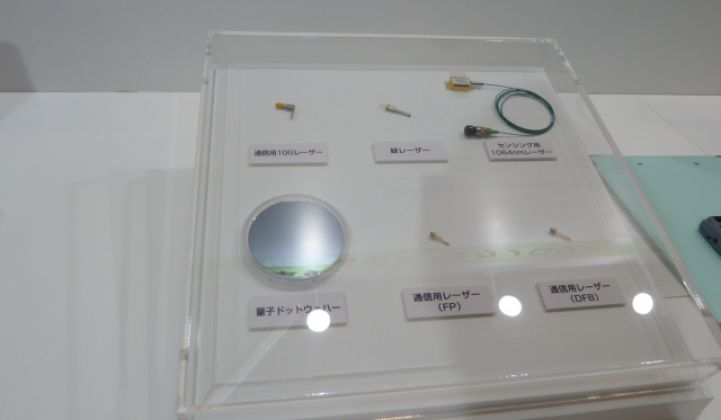Chiba, Japan -- The protocol wars aren't over yet, says Fujitsu.
The Japanese technology conglomerate has begun to tout WisReed, a long-range mesh networking technology it has developed for industrial equipment and smart meters. WisReed signals can travel 200 to 300 meters, farther than standard ZigBee and some other protocols. More importantly, the nodes are fairly efficient at configuring themselves in the field and determining the optimal path to a repeater that can then carry the data back to headquarters. Let's say temporary interference crops up in a certain area: the nodes will change their routing path quickly on the fly, according to Toshio Yagi, manager of marketing and sales support at Fujitsu during a meeting at Ceatec, a large technology trade show taking place in Japan this week.
"It monitors for the best signal all the time," he said. A collector can handle signals from around 1,000 nodes in the field.
Do other companies have similar technologies? Yes. Some like Ultra Link Processing tout signal ranges in the range of multiple miles, and others have more favorable collector-to-meter ratios. Many manufacturers also tout wired protocols, which have even fewer problems with environmental hazards. The industry, though, will likely support a number of protocols. Blanket standardization on a few select standards like USB and Wi-Fi occurred in computing because the industry consisted of hundreds of thousands, if not millions, of manufacturers serving billions of customers. Mass manufacturing and compatibility would have never occurred without monolithic standards.
By contrast, the smart grid customer base will be dominated by a somewhat finite group of utilities and industrial manufacturers, each with their own peculiar needs. These companies have the time and money to conduct individual testing and are obsessed with uptime and reliability. They also prefer to work with conglomerates. ZigBee, in other words, may not appeal to everyone.
Then again, the networking world is filled with protocols that never hit the big time. Fujitsu is also not licensing the protocol yet, which could limit its appeal.
The company is currently in talks with a few utilities and smart meter makers to conduct trials.
On other Fujitsu notes, QD Laser, a venture founded by Fujitsu and the University of Tokyo 15 years ago, has finally begun to ship its quantum dot lasers to customers. These lasers consume around 30 percent less power than conventional lasers. They also work better in hot environments, which is a big deal for data centers and control rooms that are often bathed in hot air. Approximately 50,000 lasers can be squeezed out of the four-inch wafer in the left corner of the photograph.
The first lasers will be used in conventional optical technology. In about two years, the company hopes to have a version for a scaled-down version of optical communications for connecting racks of servers or individual servers. Five years or more from now, it might be possible to swap cables inside computers with optical links, thereby curbing the power consumed by the digital world even more. Intel, Microsoft and others are working on similar optical networking concepts.



